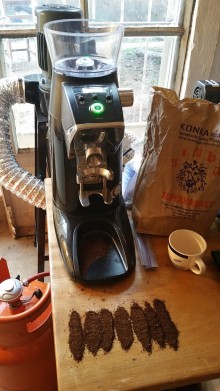Coffee Quality Manager Beth Ann Caspersen recently traveled to the Democratic Republic of the Congo to judge the country's first-ever coffee cupping competition. This is the sixth blog post in the series about the visit. Read part one here.
Day 3

These trainings also provide me with a space to talk about the unique and important aspects of being a co-op. I have been with Equal Exchange for 17 years and each time I talk about our structure as a co-op and my role in our business, I am greeted by curious faces. One of the participants said, “I didn’t know that companies like that existed in America.” I am really proud of our work as a co-op, with our farmer partners and our supply chain. We have seen a lot, done a lot, and know that there is still a lot to do.
When we learned that the water was running in the lab, we celebrated with high fives. And there was more good news - my friend and fellow cupper Moses from SOPACDI co-op had arrived to help us out. While we were still far from being ready to host a national coffee cupping competition, it felt like a few small victories.
But, I still had to assemble and train a team of people to act as the operations staff. We needed to weigh and grind the coffee, set tables and ensure that there was enough hot water to execute each cupping. We estimated that there would be 15 cuppers at the competition, and thus, we would need 108 cups for each round of cupping six coffees. I spent the late afternoon with the team explaining the purpose of our work, the importance of small details and how this experience would provide a foundation of knowledge for the lab and coffee cupping competitions in the future.
I then headed back to the roaster with Moses and after a few roasts, I found myself unable to communicate. I was worn down from poor eating, dehydration, stress and just being tired. I needed to go to sleep. I postponed my trip to the Panzi Hospital til the following morning and decided that I just needed to focus on the roaster; we only had one day left to make it all work.
Day 4
We arrived to the lab at about 8:30 on Monday morning. The roaster was hooked up, but there was no power. Eventually the generator was switched on and the roasting started. Upon reflecting the night before about the challenges I had with the sample roaster, it occurred to me, why not put in more coffee than the manual instructed? The rule of thumb in coffee roasting is to fill the barrel to approximately 66% of capacity with coffee in order to provide the beans with the proper conductive and/or convective heat for the process. The 100 grams recommended barely seemed to fill the barrel, so I increased the charge weight to 200 grams and quickly learned that it was the right move.
The development of the coffee beans were more consistent and overall the color changes and aromas were vastly improved. I was relieved to have found a workable roast solution and from then on, Moses and I worked on roasting for the entire day and night, with a brief training of the team on preparation in between. We were in business and we were going to roast those samples! Which we did, using a flashlight and headlamp, so while it wasn’t the most accurate system, it got us to where we needed to go. We finished the day exhausted yet stimulated by what we had accomplished. I told everyone how proud I was of their work and then gently instructed everyone to return to the lab less than 12 hours later at 7 a.m. for the competition.
